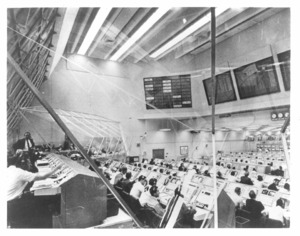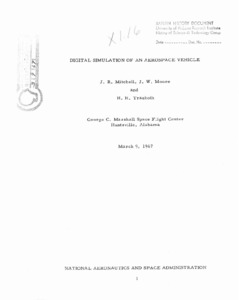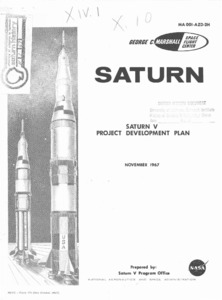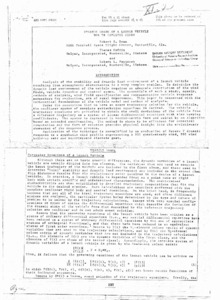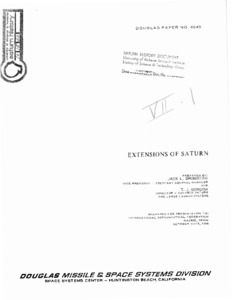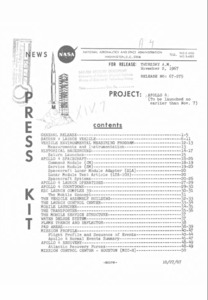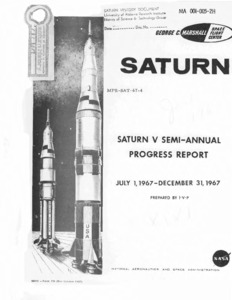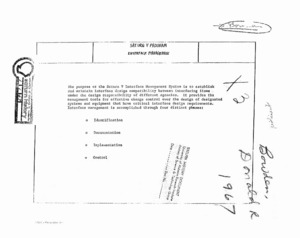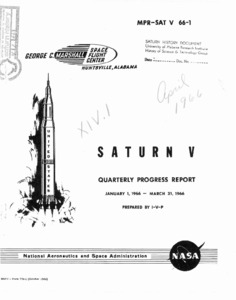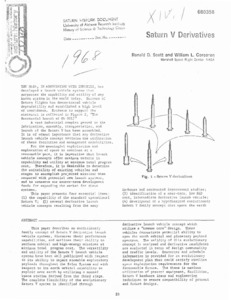
Browse Items (14 total)
Sort by:
-
"Electrical support equipment" (ESE) [photograph].
8 x 10 inch black and white photograph. A photograph of a workspace. -
"Digital Simulation of an Aerospace Vehicle."
The rapid development of computer technology and the creation of new engineering oriented languages has established that general purpose digital computers are now extremely suitable to perform simulation of large scale physical systems. With Aerospace Vehicle Simulation (AVS), an effort has been undertaken at MSFC to simulate continuous and discrete dynamics of an aerospace vehicle and its ground support equipment on a large digital computer. This simulation produces a copy of the physical vehicle configuration and its functions in the form of a large scale mathematical model in the computer. AVS will be an essential part of an integrated information system which can be used by several laboratories and offices at MSFC for the design, checkout, test, and management of aerospace vehicles. -
Saturn V project development plan : November 1967.
This document revises and supersedes the Saturn V Project Development Plan, dated March, 1967. Approved: Arthur Rudolph, Manager, Saturn V Program; Samuel C. Phillips, Major General, USAF, Director, Apollo Program. -
"Dynamic Loads of a Launch Vehicle Due to Inflight Winds."
Analysis of the stability and dynamic load environment of a launch vehicle resulting from atmospheric disturbances is a very complex problem. To determine the dynamic load environment of the vehicle requires an adequate description of the wind field, vehicle dynamics and control system. The essential of such a study, namely methods of analysis, wind field specification and representative vehicle response parameters for evaluation, are of equal importance. This paper is concerned with the mathematical foundations of the vehicle model and method of analysis. -
"Extensions of Saturn."
This paper discusses the possible applications of Saturn vehicles to future space exploration. Potential missions utilizing Apollo derived hardware are examined. Research, development, and operations in earth orbit as well as lunar exploration, unmanned and manned interplanetary exploration are reviewed. These hypothetical missions are discussed in the context of the present and potential capability of three configurations of the Saturn vehicle; an uprated Saturn I, a three-stage Saturn V and a four-stage Saturn V. NOTE: Work presented herein was conducted by the Douglas Missiles and Space Systems Division under company-sponsored research and development funds. Therefore, the concepts and objectives described within this paper reflect the opinions of the authors and do not necessarily constitute endorsement by NASA, the Air Force, or any other U.S. Government organization. The nominal performance numbers presented are typical of the current configurations and possible future vehicle configurations. -
"Apollo 4 press kit."
The flrst flight test of the Apollo/Saturn V space vehicle is scheduled for launch from the Natlonal Aeronautics and Space Administration's John F, Kennedy Space Center, Fla., no earlier than Nov. 7. The mission is designated Apollo 4. -
"Saturn V semi-annual progress report July - December, 1967."
This Saturn V Semi-Annual Progress Report describes progress and major achievements from July 1, 1967 in the Saturn V Program. -
"Saturn V interface management."
The purpose of the Saturn V Interface Management System is to establish and maintain interface design compatibility between interfacing items under the design responsibility of different agencies. It provides the management tools for effective change control over the design of designated systems and equipment that have critical interface design requirements. -
"Saturn V quarterly progress report : January - March."
Quarterly progress report for the months of January - March, 1966. -
"Saturn V derivatives."
This paper desciibes an evolutionary family concept of !h turn V derivative launch vehicle systems, discusses their performance capabilities, and outlines their ability to perform orbital and hlgh-energy missions at minimum total program cost.
